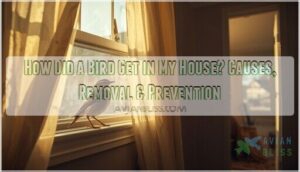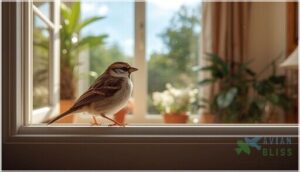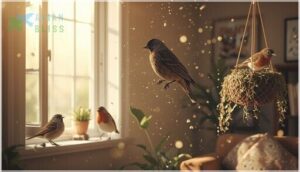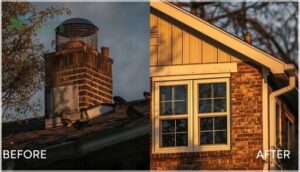This site is supported by our readers. We may earn a commission, at no cost to you, if you purchase through links.
You’re sitting in your living room when a sudden flutter catches your eye. A bird is inside your house, and you have no idea how it got there. This happens more often than you’d think.
Birds slip into homes through surprisingly small openings—gaps as narrow as half an inch in your siding, uncapped chimneys, bathroom vents left unscreened, or simply an open door during the two seconds you carried in groceries.
They’re not trying to invade your space. Most are just following their instincts toward shelter, food, or a safe nesting spot. Understanding these entry points helps you remove your unexpected guest safely and prevent future visits.
Table Of Contents
- Key Takeaways
- Common Ways Birds Enter Homes
- Bird Behavior That Leads to Intrusion
- Bird Species Likely to Enter Houses
- Signs You Have a Bird Inside
- Risks of Birds in Your Home
- Safe and Humane Bird Removal Steps
- Preventing Future Bird Infestations
- Effective Bird Deterrent Methods
- Top 4 Bird Deterrent Products for Homes
- When to Hire Bird Control Professionals
- Frequently Asked Questions (FAQs)
- What to do if a bird gets in your house?
- What does it mean if a bird comes in your house?
- Why would a bird try to get in my house?
- Where do birds hide in your house?
- What do I do if a bird is injured inside?
- How can birds impact indoor air quality?
- Are certain home materials more attractive to birds?
- Do birds carry diseases harmful to humans?
- What legal protections exist for removing birds?
- Can birds carry diseases harmful to pets?
- Conclusion
Key Takeaways
- Birds slip into homes through surprisingly small gaps—half-inch cracks in siding, uncapped chimneys, unscreened vents, or open doors—often while following instincts for shelter, food, or nesting spots rather than deliberately invading your space.
- Common culprits like sparrows, starlings, and pigeons create real hazards once inside, including disease transmission through droppings (histoplasmosis, psittacosis), fire risks from nesting materials blocking vents, and property damage costing $500 to $5,000 in repairs.
- Safe removal starts with staying calm and quiet (which reduces bird stress by 30% and improves self-evacuation rates by 75%), opening one exterior door or window wide, turning off interior lights, and never handling birds directly to avoid injury and disease exposure.
- Prevention beats removal every time—seal all entry points with caulk and screens, install bird-proof vent covers (reducing intrusions by 90%), trim trees six feet from your roof, and combine visual deterrents like reflective discs with physical barriers like spikes for long-term protection.
Common Ways Birds Enter Homes
Birds don’t need a red carpet to find their way inside—they’re surprisingly good at spotting even the smallest gaps and openings in your home. Most of the time, they aren’t trying to invade your space on purpose.
They’re just following their instincts to find food, shelter, or a safe place to nest, and your house happens to offer an easy way in.
Open Doors and Windows
When you leave doors or windows open, especially during warmer months, you’re practically rolling out the welcome mat for birds. A bird flies into your house through these unscreened openings more often than you’d think—43% of bird collisions happen at homes this way. Human negligence plays a big role here.
Birds often mistake reflections in glass for open space, which is why birds see habitat and collide with windows. Entry prevention starts with simple awareness and keeping openings secured when unattended.
Chimneys and Roof Openings
While doors and windows are obvious entry points, your chimney is an even bigger culprit. Uncapped chimneys practically invite birds to nest inside, with 70% of these openings seeing bird intrusions annually. Chimney swifts and other species love these warm, sheltered spots.
Nesting debris risks include blocked airflow and carbon monoxide buildup. Roof opening dangers extend to damaged shingles and gaps in soffits.
Chimney cap installation stops most problems before they start, as they’re effective at preventing dangerous bird infestations.
Vents and Exhaust Fans
Your bathroom vent, dryer exhaust, and roof ventilation systems are prime targets for starlings and sparrows seeking cozy nesting spots. These determined birds can pry open flap-style vent guards, stuffing twigs and dry grass inside.
The result? Airflow blockage that causes dangerous heat buildup and fire hazards from flammable nesting materials.
Effective exclusion methods start with heavy-duty steel vent covers that block access while maintaining proper ventilation.
Cracks in Walls and Foundations
Your home’s foundation can develop cracks as small as 0.6 inches—just wide enough for sparrows and starlings to squeeze through. These building invaders target structural weaknesses in older houses, which face 40% higher intrusion risk.
Once inside wall cavities, birds damage insulation and accelerate material decay by 20%.
Seal foundation cracks with concrete patches or epoxy to cut entry risk by over 90% and protect your home security.
Gaps in Siding and Trim
Between your siding and trim, gaps as small as half an inch create perfect hideouts for seed-caching birds and insect prey. Wood siding with grooves attracts woodpeckers drilling for larvae, while aging materials warp and enlarge these openings.
Over 90% of homes with grooved siding harbor insects in gaps, drawing persistent bird activity. Seal joints with industrial sealants and inspect rooflines regularly to prevent costly intrusions and protect your ventilation systems.
Bird Behavior That Leads to Intrusion
Birds don’t just stumble into your home by accident. Their intrusions are usually driven by specific needs or environmental cues that make your house look like the perfect spot to land.
Let’s look at the key behaviors that lead birds indoors and why they happen.
Attracted to Food and Water
Ever wonder why that sparrow keeps circling your patio? Birds follow their noses—and eyes—to food and water. With over 57 million U.S. households feeding backyard birds, you’re creating an attractive facility environment that draws them closer to your home’s exterior.
Here’s what pulls them in:
- Bread and seeds left outside attract house sparrows and doves
- Pet water bowls offer easy hydration, especially during seasonal heat
- Bird feeders increase urban bird feeding and visitation year-round
- Open food sources trigger persistent feeding behaviors near entry points
Human impact on bird attractiveness conditions means they’ll venture inside searching for these essentials.
Seeking Shelter and Nesting Sites
When temperatures drop or storms roll in, birds scout for safe nesting sites near your home. Over 75% of breeding birds settle within 100 meters of human structures, drawn by reduced predators and reliable shelter.
Urban nesting sites like your attic, vents, and eaves offer year-round protection. Man-made structures mimic natural cavities, and landscape factors—especially moderate tree coverage—make your property irresistible for birds nesting nearby.
Following Insects Indoors
Birds chasing bugs don’t always stop at your doorstep. Insect-bird link drives roughly 90% of bird species to hunt indoors when prey is plentiful. During seasonal intrusion peaks, insectivorous birds like chickadees or swallows may follow moths and flies through open windows.
If pest control hasn’t addressed your insect problem, you’re basically laying out a buffet that attracts nuisance wildlife right into your living space.
Unaddressed insect problems basically lay out a buffet that attracts nuisance wildlife straight into your home
Disorientation From Weather or Lights
Artificial lights can turn your home into a disorienting trap for migrating birds. Urban lighting installations have affected over a million birds in single studies, causing them to circle, slow down, and lose their way. Weather influence combines with magnetic disturbances to create perfect conditions for birds to get lost—and when a disoriented bird flies into your house through an open window, it’s often struggling with:
- Strong winds or heavy cloud cover blocking navigation cues
- Geomagnetic disturbances reducing flight effort by 25%
- Light disorientation from ground-based beams reaching 4 km high
- Temperature shifts driving unexpected migration intensity
- Avian vagrancy caused by magnetic field irregularities
These migration challenges don’t discriminate—young and experienced birds both struggle. If you’re wondering how a bird got into your building during storm season, atmospheric chaos likely played a role. The bird-attractiveness condition worsens when weather and artificial lights combine. Fortunately, you can get the bird out safely once you understand what drove it indoors.
Mistaking Reflections for Openings
Your windows may be luring birds straight into danger. Reflection illusions make glass look like open sky or habitat, fooling species like Cedar Waxwings—which account for over 60% of strikes in some studies. These behavioral triggers intensify during breeding seasons, when territorial birds attack their own reflections. Light conditions throughout the day shift collision risks, making prevention critical.
| Risk Factor | Impact on Birds | Prevention Method |
|---|---|---|
| Mirrored glass | 17x higher strike rates | Bird-friendly treatments reduce strikes by 84% |
| Nearby vegetation reflections | 2.3x increased collision odds | Trim trees near reflective windows |
| Territorial behavior | Repeated strikes, injury | Install exterior window markers |
When a bird flies into house windows repeatedly, it’s not seeing an opening—it’s seeing a rival or escape route that doesn’t exist. Species vulnerability varies, but migration seasons bring the highest collision rates. Understanding mitigation data helps: applying simple sticky dots or films breaks up reflections effectively. If you’re facing ongoing bird removal needs from window strikes, addressing reflection confusion is your first defense.
Bird Species Likely to Enter Houses
Not all birds are equally likely to find their way into your home. Some species are naturally drawn to human structures because of their nesting habits, diet, or comfort around people.
Here’s a look at the birds you’re most likely to encounter indoors.
Sparrows and Starlings
Among the most frequent indoor intruders, sparrows and starlings often nest in eaves, vents, and attics. Despite a 90% population decline in House Sparrows since 1970, they’re still common culprits. Here’s what you should know:
- Starlings prefer cavities like vents and chimneys
- Both species build nests from twigs inside attics
- Starling colonies increase property damage risks
- Their droppings carry airborne diseases
- Professional wildlife removal ensures safe bird removal
Pigeons and Doves
In urban areas, Pigeons dominate rooftop ledges and often enter through vents or chimneys, creating serious issues. Their nesting materials can block airflow and spark electrical fires near wiring.
These birds carry histoplasmosis and cryptococcosis in their droppings—real disease vectors you can’t ignore.
Mourning doves prefer quieter spots like porches.
Professional bird control addresses both urban roosting problems and prevents ongoing damage.
Swallows and Finches
Swallows nest under eaves during migration patterns, slipping through vents when seeking shelter. Tree swallows favor backyard habitats near water but explore open porches too.
House finches and other finch varieties chase insects indoors, entering through window cracks. Their nesting habits create unsanitary conditions as droppings pile up.
Swallow entry often means mite problems follow. Removing birds from homes requires addressing these small openings before infestations spread.
Robins and Blue Jays
American robins build nests on ledges and eaves, sometimes slipping into garages through open doors. Blue jays, while less common indoors, peck at loose siding or enter through windows chasing food.
Both birds show territorial behavior during breeding season, returning to the same spot repeatedly. Their nesting habits mean you’ll need coexistence strategies or professional help getting birds out before damage spreads.
Signs You Have a Bird Inside
You mightn’t see the bird right away, but the signs are usually hard to miss. From strange sounds to physical evidence scattered around your home, a bird inside leaves clues that something’s off.
Here are the telltale signs you’re sharing your space with an unexpected guest.
Droppings and Nesting Material
One of the clearest signs of a bird infestation is finding droppings and nesting material scattered around your home. You’ll often spot these in attics, near vents, or along window sills. Here’s what to watch for:
- White or dark droppings containing diseases like histoplasmosis
- Sticks, leaves, and feathers from bird nest construction
- Accumulated waste creating slippery surfaces
- Nesting composition blocking vents or creating fire hazards
- Frequent droppings indicating active bird infestation
Clean these areas carefully using proper procedures to protect your health.
Feathers and Bird Tracks
Finding scattered feathers and faint bird tracks near your windows or entry points often means you’ve got an unwelcome visitor. Track characteristics like small footprints measuring 2 to 5 cm help identify the species.
Feather identification paired with forensic advances in residue evidence shows where birds entered and roosted. These clues make bird removal faster and help you get bird out safely.
Chirping and Bird Calls
Hearing constant chirping inside your house? Birds vocalize between 1,000 and 8,000 Hz—well within human hearing range—to mark territory and signal distress. Call frequency increases when birds feel trapped.
Chirping function goes beyond communication; it helps you locate the bird quickly. Detection tech like acoustic monitors can pinpoint hidden birds in attics.
Understanding bird behavior and psychology speeds up safe removal and protects human well-being.
Unpleasant Odors or Stains
Yellow ceiling stains and a musty smell often point straight to bird droppings or decaying nest material. Droppings odor spreads through vents, compromising air quality and signaling health risks like respiratory issues.
Attic cleaning becomes essential when stain removal fails with basic cleaners—property damage and restoration require enzyme-based solutions. These odor indicators demand immediate attention to prevent insulation damage and ongoing disease exposure.
Damage to Insulation or Drywall
Birds pecking through attic spaces can tear insulation apart, reducing your home’s energy efficiency by up to 30%. You’ll spot displaced fibers, droppings damage saturating materials, and drywall cracks near entry points.
Nesting impact creates gaps that spike heating bills, while contaminated insulation often needs full replacement.
Repair costs climb quickly—expect $500 to $2,000 for professional restoration addressing both insulation degradation and structural fixes tied to roofing issues.
Risks of Birds in Your Home
Having a bird in your home isn’t just an inconvenience—it can actually put your health and property at risk. From hidden diseases in droppings to unexpected damage throughout your house, these visitors create problems you mightn’t see right away.
Here are the main risks you should know about when birds make their way indoors.
Disease Transmission From Droppings
Over 60 diseases can spread through bird droppings, making them serious dropping disease vectors. You’re at risk for respiratory illnesses like histoplasmosis and psittacosis, which thrive in dried droppings. Systemic infections such as salmonellosis cause severe gastrointestinal distress.
Environmental factors like poor ventilation increase exposure through transmission mechanisms, including inhalation of contaminated dust.
Professional bird removal and pest control protect your environmental health from these hidden health risks and diseases.
Secondary Pest Infestations
Beyond the diseases from droppings, you’ll face secondary pest infestations once birds nest in your home. Bird mite bites cause itchy red welts when these parasites seek new hosts. Rodent nest attraction increases as mice follow food trails from bird debris.
Insect vector diseases like Lyme spread through fleas and ticks.
Structural nest damage worsens with recurring infestations. Effective pest control measures and bird infestation prevention stop this cycle.
Fire Hazards From Nesting Materials
Nesting materials pose serious fire hazards when birds build inside your home. Dry twigs, grass, and synthetic fibers ignite easily near heat sources. Vent blockage from nests causes dryers to overheat, while chimneys with nest flammability issues trigger unpredictable fires. These ignition sources also trap carbon monoxide indoors.
Fire prevention starts with regular inspections of roofing and ventilation issues, plus prompt bird removal from dangerous areas.
Property Damage Costs
The financial toll from bird intrusions hits harder than most homeowners expect. Droppings corrosion eats through roofing and siding, while nesting damage blocks vents and gutters. You’re looking at real costs:
- Insulation repair averages $1,000 to $2,700 after birds tear it apart
- Chimney repair ranges from $150 to $1,500 when nests cause blockages
- Equipment failures from corroded HVAC systems add hundreds more
Insurance exclusions often leave you covering these expenses yourself.
Decline in Indoor Air Quality
When avian infestation reaches your HVAC system, your home’s air turns into a health risk. Bird droppings near vents release fungal spores and bacteria that circulate through every room. Dried feces create particulate matter carrying pathogens.
Feather dust and nesting debris clog filters, reducing airflow by 30% while pumping airborne allergens throughout your space. Your family’s respiratory health depends on catching this early.
Safe and Humane Bird Removal Steps
If a bird’s made its way into your home, your first move is to help it leave without causing panic or injury. The right approach keeps both you and the bird safe while making the escape as quick and stress-free as possible.
Here’s what you need to do.
Staying Calm and Quiet
When a bird gets trapped in your building, your first instinct might be to act fast—but that’s exactly what you shouldn’t do. Staying calm and quiet is your best strategy. Studies show that quiet bird removal reduces bird physiological stress by up to 30% and improves self-evacuation success rates by 75%.
Here’s how to maintain quiet calmness during bird removal:
- Breathe slowly to reduce human stress and model calm behavior
- Speak softly or not at all—loud noises increase bird panic by 90%
- Move deliberately without sudden gestures that startle trapped birds
- Lower ambient noise by turning off TVs, radios, and appliances
- Give space so the bird doesn’t feel cornered or threatened
Benefits of quietness extend beyond immediate removal. When you stay composed, birds are 65% less likely to injure themselves through frantic flight. Your heart rate naturally drops about 8% when you remain still, which helps you think clearly about removing birds from homes safely. Calm surroundings also reduce the chances of birds hiding in hard-to-reach spots by 40%, making the entire process smoother for everyone involved.
Creating a Clear Exit Path
Once you’ve calmed down, your next move is simple: open one exterior door or window wide. Birds instinctively fly toward natural light, so turn off interior lights and let daylight guide them out.
Clear furniture and obstacles near the exit to create an open path. Close interior doors to confine movement to one room, making bird removal faster and less stressful for everyone.
Avoiding Direct Handling
Never try to grab or catch the bird with your bare hands. Direct handling increases stress on the animal and puts you at risk for zoonotic disease risks and injury from bites or scratches. Wild birds also carry legal protections in many areas.
Instead, use wildlife control techniques like gentle herding with a sheet toward your exit, supporting both ethical removal and animal welfare.
Using Protective Gear
Even when you’re not touching the bird directly, protective gear shields you from droppings, feathers, and airborne contaminants during removal. Here’s what wildlife safety experts recommend:
- Glove Materials – Use disposable waterproof or thick leather gloves to prevent contact with pathogens
- Respiratory Masks – Wear N95 respirators in confined spaces to block dust and dried droppings
- Eye Protection – Safety goggles guard against splashes and airborne particles
Dispose of all gear safely after use.
When to Call a Professional
Some situations go beyond what you can safely handle alone. Large infestations, health concerns from droppings, or damage repairs requiring immediate attention demand professional Wildlife Removal experts.
Bird Removal Services offer remediation services and effective Bird Exclusion that DIY methods can’t match.
When Animal Control and Pest Management specialists implement Wildlife Infestation Prevention, you’re protected both now and later. That peace of mind matters.
Preventing Future Bird Infestations
Once you’ve removed the bird, your next step is making sure it doesn’t happen again. The good news is that most bird problems can be prevented with a few simple fixes around your home.
Here are the most effective ways to keep birds outside where they belong.
Sealing All Entry Points
You’ll want to seal every possible gap before birds find their way back. Use caulk and sealants around windows, and install door sweeps under entry doors. Cover chimneys with caps and add vent screens to all openings.
Professional inspections can spot vulnerabilities you might miss.
These animal exclusion methods form your first line of defense in effective bird exclusion strategies.
Installing Bird-Proof Vent Covers
Beyond sealing gaps, you need bird-proof vent covers to keep birds from nesting in dryer and exhaust openings. Opt for galvanized or stainless steel—they reduce bird intrusion by up to 90%. Installation cost runs $49 to $150 per vent, depending on cover material and code compliance needs.
Five Key Vent Cover Benefits:
- Blocks bird nesting while maintaining proper airflow
- Prevents fire hazards from debris buildup
- Lowers energy bills by keeping vents clear
- Reduces mites and secondary pest infestations
- DIY install is possible, but professional work ensures vent maintenance standards
These animal exclusion tools work alongside other bird deterrents. Pair them with chimney caps for complete home protection.
Trimming Trees and Shrubs Near Home
Trimming trees and shrubs near your home cuts down on bird perches and nesting spots. Focus on vegetation management outside the Nesting Season—August through November works best for Safe Trimming.
Keep branches at least six feet from your roof and siding. This habitat preservation approach balances property protection with Legal Considerations, since many bird species have federal protection during nesting months.
Using Netting or Screening on Openings
Bird deterrents like netting and screening work best with the right mesh size—½ inch or smaller blocks most species. Installation quality matters more than material durability, since gaps let birds slip through.
During home maintenance, cover vents and chimneys first. Watch for entanglement risks with damaged nets, and remember aesthetic concerns if you’re covering visible areas.
Bird repellents won’t help if openings stay exposed.
Effective Bird Deterrent Methods
Once you’ve sealed up your home, the next step is keeping birds from wanting to come back. There are several proven methods that make your property less appealing to birds without harming them.
Let’s look at the most effective deterrent options you can use around your home.
Visual Deterrents and Reflective Objects
Reflective surfaces can confuse and deter birds before they reach an open window or vent. High-visibility reflective tape reduces pest bird presence to just 0.09% in controlled tests, while compact discs achieve 0.41%.
For best placement and habituation prevention:
- Reposition deterrents weekly to avoid species variation in response
- Use wind and light to increase reflectivity degradation resistance
- Combine methods for cost effectiveness
These bird repellents work best as part of broader Bird Deterrents and Repellents strategies supporting window safety.
Bird Spikes and Physical Barriers
When deterrents alone aren’t enough, physical barriers offer lasting protection. Bird spikes reduce pigeon populations by nearly 70%, while properly installed netting achieves up to 100% exclusion rates. These humane Wildlife Control solutions prevent injury while addressing Pest Control and Management needs.
With the market projected to reach $400 million by 2033, installation costs average $300–$1,200—a worthwhile investment in barrier benefits and spike efficacy.
Natural Predators and Decoys
While decoy deployment can leverage natural predator effectiveness against unwanted birds, results vary widely. Moving raptor models show strong behavioral impact—clearing areas completely in studies—while static owls lose their edge as birds catch on.
The comparative efficacy favors lifelike movement over Flock Free or other repellents. Plus, ecological considerations make predator-based deterrents a humane choice that respects animal behavior.
Repellent Sprays and Gels
When choosing between gel and spray formulations, consider your specific needs. Chemical repellents like Flock Free show 44–47% efficacy in reducing bird presence, while gels from XclusionPro or AAC Distributing offer months-long protection on surfaces. Both meet regulatory compliance and application safety standards.
For pest management, sprays work well for broad coverage, while gels excel in precise placements with minimal environmental impact.
Top 4 Bird Deterrent Products for Homes
You’ve got plenty of bird deterrent options, but some products stand out for actually getting the job done.
The four tools below have proven track records for keeping birds away from homes without harming them. Each one works differently, so you can pick what fits your specific bird problem.
1. Reflective Bird Scare Discs Set
You’ve likely seen those shiny discs spinning in gardens—they’re more than decoration. Reflective bird scare discs use light and movement to create an unpredictable visual zone that keeps pigeons, sparrows, and woodpeckers at bay.
Studies show they can reduce bird presence by up to 30% when deployed correctly. Each disc covers roughly 100 square feet, making them practical for patios, windows, and garden areas.
The key? Relocate them every few weeks to prevent birds from getting used to them, and combine with other deterrents for lasting home safety and pest management results.
Best For: Homeowners and gardeners looking for a humane, low-maintenance way to protect outdoor spaces from common pest birds like pigeons, sparrows, and woodpeckers without ongoing costs or complicated setup.
- Proven effective in studies, reducing bird presence by up to 30% when placed strategically, with each disc covering around 100 square feet of space.
- Easy to install with multiple mounting options (screws, zip ties, adhesive) and no electricity or ongoing maintenance required—just hang and forget.
- Safe and eco-friendly method that doesn’t harm birds, pets, or people, making it ideal for families and environmentally conscious users.
- Birds can get used to them over time, so you’ll need to move the discs every few weeks to keep them working effectively.
- Works best in sunny, windy conditions where the reflection and movement are strongest—shaded or calm spots may see less impressive results.
- Some users report the discs can crack, rust, or create annoying glare if hung too close to windows or living areas.
2. Mirror Polished Stainless Steel Gazing Balls
These gleaming spheres don’t just catch your eye—they catch birds’ attention in ways that discourage landing. Mirror polished stainless steel gazing balls create 360-degree visual deterrence through rapid light shifts and reflections that disorient approaching birds.
Deployment trends show homeowners placing multiple balls near patios and water features for maximum coverage. Made from corrosion-resistant 304-grade steel, they require minimal maintenance compared to other bird repellent options.
Cost analysis reveals strong long-term value: most last 5+ years outdoors, protecting your house while adding garden appeal.
Best For: Homeowners looking for a low-maintenance, long-lasting bird deterrent that doubles as an attractive garden decoration.
- The 360-degree mirror finish creates dynamic light reflections that effectively discourage birds from landing near patios, ponds, and outdoor spaces.
- Made from durable 304-grade stainless steel that resists corrosion and lasts 5 years outdoors with minimal upkeep—just occasional cleaning to restore shine.
- Serves dual purpose as both functional bird control and stylish garden decor, available in multiple sizes to fit different spaces and design needs.
- Higher upfront cost compared to simpler reflective deterrents like tapes or hanging discs, though the long-term value offsets this.
- Product photos can be misleading—the balls often look larger online than they actually are, which may disappoint buyers expecting bigger spheres.
- The polished surface can scratch or dent if not handled carefully during setup or maintenance, reducing reflective effectiveness over time.
3. Aspectek Bird Spikes Deterrent Kit Glue
When birds find their favorite perches, you need a solution with real staying power. The Aspectek Bird Spikes Deterrent Kit covers 10 feet of ledges, eaves, or gutters with UV-protected stainless steel prongs that won’t rust or fade.
Its adhesive strength bonds to concrete, wood, and steel within 24 hours, creating a humane deterrent that stops pigeons and starlings without harm.
Product lifespan averages over five years, making spike installation a cost-effective bird repellent for ongoing home maintenance and repair needs—no wildlife removal services required.
Best For: Homeowners and property managers looking for a long-lasting, humane way to keep medium to large pest birds off ledges, roofs, and gutters without ongoing maintenance costs.
- Covers 10 feet per kit with durable UV-protected stainless steel spikes that last over five years in all weather conditions, reducing bird intrusion by up to 90%.
- Installs quickly in about 40 minutes using included weatherproof adhesive that bonds to concrete, wood, brick, and steel within 24 hours.
- Flexible 360-degree base adapts to curved and uneven surfaces like antennas, railings, and support beams while remaining humane and safe for birds.
- Less effective against small birds like sparrows that can squeeze between spikes, often requiring additional netting or deterrents for complete coverage.
- Adhesive may not work well on all surfaces or extreme conditions, and spikes can become brittle or break if not installed correctly.
- Limited 30-day warranty and potential need for professional installation near electrical areas to meet safety codes.
4. Flock Free Bird Repellent Spray
While spikes work for perches, you’ll need a different approach for open areas like patios and yards. Flock Free Bird Repellent Spray offers a natural solution using peppermint, garlic, and rosemary oils to irritate birds’ senses without harming them.
Spray it twice weekly for two weeks, then cut back to monthly maintenance. It’s safe around pets and kids, dries clear, and keeps pigeons and sparrows away for months.
User reviews confirm it works best with consistent application—skip treatments and birds return quickly.
Best For: Homeowners looking for a natural, pet-safe spray to keep birds away from patios, yards, and small outdoor areas without harming them.
- Made with all-natural oils (peppermint, garlic, rosemary) that are safe around kids, pets, and livestock while effectively irritating birds’ senses.
- Dries clear without visible residue or smell, making it ideal for use on patios, decks, and other visible areas around your home.
- Long-lasting protection with proper maintenance—results can last several months once you’ve established the initial treatment schedule.
- Requires consistent application for the first month (twice weekly, then weekly) before you can reduce to monthly maintenance, which takes commitment.
- Not ideal for large open areas since it’s designed for spot treatments—you’d need the concentrated version for bigger spaces.
- Effectiveness varies by situation and some users report limited success, especially if they don’t stick to the recommended spray schedule.
When to Hire Bird Control Professionals
Sometimes a bird problem is more than you can handle on your own. If you’re dealing with a stubborn infestation, health risks, or serious property damage, it’s time to call in the experts.
Here are four situations when professional bird control services are worth the investment.
Large or Repeated Infestations
When should you call in the experts? If you’re dealing with repeat invasions, professional help becomes essential. Properties with untreated infestations are 65% more likely to see birds return.
Recurring issues often signal overlooked entry points or species patterns that need specialized attention. Starlings and sparrows, responsible for over 62% of persistent nest-building, require targeted management success strategies that go beyond DIY fixes.
Health and Safety Concerns
Protecting your family’s well-being comes first. Disease transmission from droppings causes serious lung infections like histoplasmosis and psittacosis—the latter requiring hospitalization in 10% of cases. Secondary pests, including mites and ticks, bring Lyme disease risks into your home.
Fire hazards from blocked vents contribute to 2,900 annual house fires. Poor air quality triggers respiratory symptoms, especially for children with asthma.
Professional wildlife control operators have the protective gear and training to handle these bird-related emergencies safely.
Damage Requiring Repairs
Structural issues need immediate attention. Roof damage from nest-building and gutter clogs lead to water infiltration—repairs run $500 to $5,000. Dropping corrosion eats through metal and paint, while nesting damage in your attic compromises insulation. Wiring hazards create fire risks you can’t ignore.
Professional inspections catch hidden problems, coordinating roof repair, chimney repair, and insulation repair before small issues become catastrophic failures requiring complete home maintenance overhauls.
Remediation and Cleaning Services
Beyond simple removal, you need dropping removal and sanitation methods that meet industry standards. Wildlife technicians from services like Critter Control or AAC Distributing use HEPA vacuums and protective gear to eliminate toxic waste safely.
Animal removal and relocation is just the start—damage repair restores insulation and sealing.
Cost factors range from $200 to $900 for attic cleaning, with full remediation reaching $1,000 to $3,000 depending on infestation severity.
Frequently Asked Questions (FAQs)
What to do if a bird gets in your house?
Think of it like guiding a lost guest to the door. Stay calm, open windows and doors wide, dim the lights, and give the bird space to find its way out naturally.
What does it mean if a bird comes in your house?
A bird entering your home can carry spiritual meanings across cultures—messages from departed loved ones, omens of change, or symbols of evolution.
Practically, it often signals accidental entry through open windows or structural gaps requiring animal removal and sealing.
Why would a bird try to get in my house?
Like moths to a flame, birds are drawn to your home by light attraction, food sources, and shelter seeking.
Urban adaptation and navigational errors also lead to accidental intrusions, especially near windows.
Where do birds hide in your house?
Once inside, birds seek out dark, quiet spaces. Attics, chimneys, vents, and wall voids offer shelter from predators.
You’ll also find them concealed behind appliances, in closets, or roosting near gutter systems.
What do I do if a bird is injured inside?
If you find an injured bird inside, move it to a quiet, dark space right away. Use a cardboard box lined with cloth, then contact a licensed wildlife rehabilitator immediately for proper care.
How can birds impact indoor air quality?
When birds nest indoors, their droppings release pathogens and allergens that worsen airborne toxins.
HVAC contamination spreads microbial impact throughout your home, creating environmental health risks and reducing overall air quality considerably.
Are certain home materials more attractive to birds?
Yes. Glass surfaces cause up to 1 billion bird collisions annually in North America. Untreated glass, architectural gaps over 5 cm, and rough wood attract birds, while bird-safe retrofitting reduces strikes by 89%.
Do birds carry diseases harmful to humans?
Absolutely. Zoonotic diseases like psittacosis affect humans exposed to bird droppings, with nearly 20% of cases involving secondary pest infestations.
Fungal infections and parasitic risks also threaten health, especially for vulnerable populations.
What legal protections exist for removing birds?
Federal law under the MBTA compliance framework prohibits nest removal of active migratory bird nests.
State regulations and incidental take rules require professional bird rehabilitation services for humane wildlife management, ensuring animal welfare and environmental conservation.
Can birds carry diseases harmful to pets?
Like uninvited guests at a dinner party, birds bring more than their presence—they carry avian influenza and zoonotic pathogens. Transmission pathways include droppings and direct contact.
Prevention safeguards protect your pets from serious disease effects.
Conclusion
Picture yourself walking into a quiet, bird-free home—no fluttering wings, no surprise guests overhead. Now that you know how did a bird get in my house, you’re equipped to spot vulnerabilities before they become problems.
Seal those gaps, screen your vents, and keep doors closed when possible. A little prevention goes a long way. Your home stays yours, and the birds stay exactly where they belong—outside, thriving in their natural habitat.
- https://www.skedaddlewildlife.com/location/whitby/blog/common-ways-birds-can-enter-your-home-this-summer/
- https://krittercatchersnj.com/seasonal-wildlife-behavior-when-and-why-animals-invade-residential-spaces/
- https://www.audubon.org/news/hundreds-millions-birds-are-killed-annually-building-collisions
- https://wildgoosechasers.com/bird-pigeon-control-geese-removal-blog/bird-related-indoor-air-quality-issues-a-threat-to-human-health/
- https://aviationweek.com/air-transport/bird-strikes-cost-364-million-insurance-claims-study-says

















